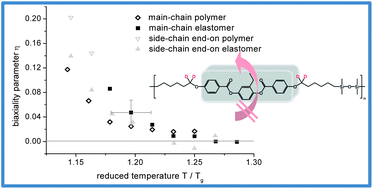Molecular dynamics and biaxiality of nematic polymers and elastomers
Abstract
To gain insight into the origins of phase biaxiality in nematic

* Corresponding authors
a
Institut für Makromolekulare Chemie, Stefan-Meier-Str. 31, Freiburg i. Br., Germany
E-mail:
felicitas.broemmel@makro.uni-freiburg.de, anke.hoffmann@makro.uni-freiburg.de
Fax: +49 761 2036306
Tel: +49 761 2036267
b
Physikalisches Institut, Hermann-Herder-Str. 3, Freiburg i. Br., Germany
E-mail:
stille@uni-freiburg.de
Fax: +49 761 2035855
Tel: +49 761 2035862
To gain insight into the origins of phase biaxiality in nematic

 Please wait while we load your content...
Something went wrong. Try again?
Please wait while we load your content...
Something went wrong. Try again?
F. Brömmel, W. Stille, H. Finkelmann and A. Hoffmann, Soft Matter, 2011, 7, 2387 DOI: 10.1039/C0SM01116A
To request permission to reproduce material from this article, please go to the Copyright Clearance Center request page.
If you are an author contributing to an RSC publication, you do not need to request permission provided correct acknowledgement is given.
If you are the author of this article, you do not need to request permission to reproduce figures and diagrams provided correct acknowledgement is given. If you want to reproduce the whole article in a third-party publication (excluding your thesis/dissertation for which permission is not required) please go to the Copyright Clearance Center request page.
Read more about how to correctly acknowledge RSC content.
 Fetching data from CrossRef.
Fetching data from CrossRef.
This may take some time to load.
Loading related content
